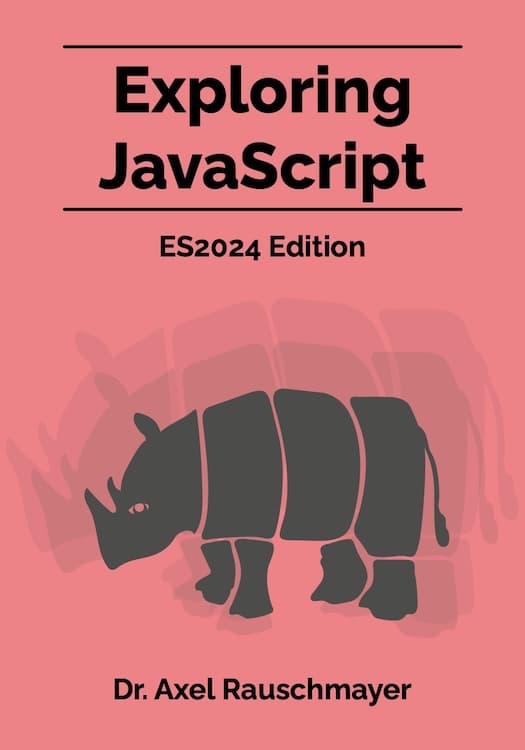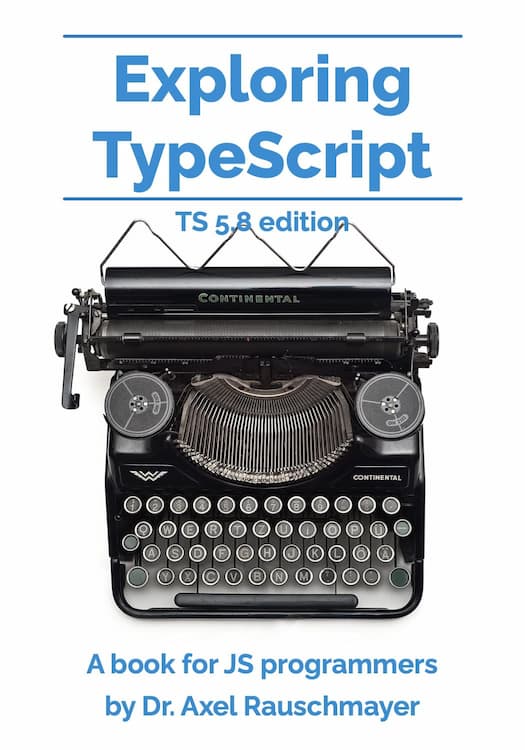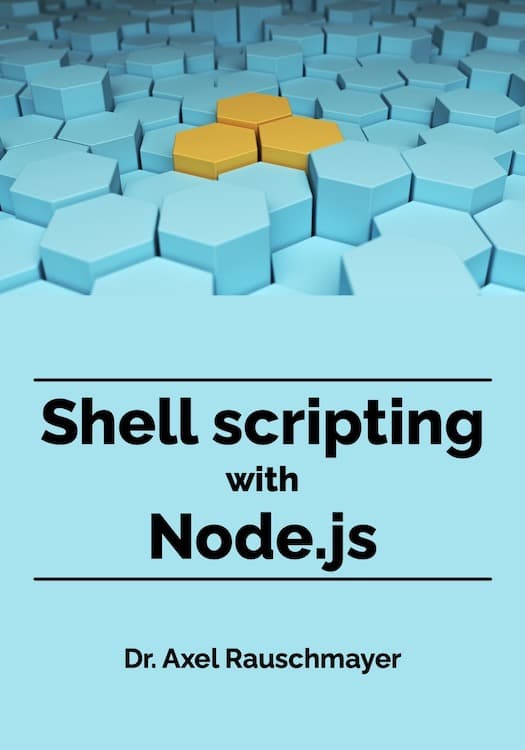[Web dev for beginners] HTML: Learn the essentials quickly
This blog post is part of the series “Web development for beginners” – which teaches people who have never programmed how to create web apps with JavaScript.
To download the projects, go to the GitHub repository learning-web-dev-code and follow the instructions there.
I’m interested in feedback! If there is something you don’t understand, please write a comment at the end of this page.
In this chapter, we learn how to create web pages via HTML.
Knowledge we need for this chapter
Hexadecimal numbers
You will not need this knowledge very often but it is helpful to have a rough idea of what hexadecimal numbers are because they regularly come up in web development.
- Decimal numbers are based on the number ten: “10” means ten, “100“ means one hundred (ten times ten), etc. They have the following digits (a number consists of one or more digits):
0123456789 - Hexadecimal numbers are based on the number sixteen: “10” means sixteen, “100” means 256 (sixteen times sixteen), etc. They have the following digits:
0123456789ABCDEF
We can even convert numbers from hexadecimal to decimal via JavaScript: If a number literal starts with Ox (x stands for heXadecimal) then it is interpreted as a hexadecimal number:
> 0x9
9
> 0xA
10
> 0xF
15
> 0x10
16
> 0xFF
255
> 0x100
256
Why are hexadecimal numbers convenient in computing? Because the numerical range of four bits is 16: 2 × 2 × 2 × 2. One bit has a range of two – it can represent two numbers.
File paths
Roughly, file systems have two kinds of entries:
- Directories (folders)
- Files
A path specifies the location of an entry in a file system. It consists of a series of zero or more names of parent directories followed by the name of an entry. These names are separated by:
- Web and Unix: slashes (
/) - Windows: backslashes (
\)
These are examples of Unix file paths:
-
The empty path
/refers to the top-level directory (the root directory). -
Absolute paths start at the root level:
/home/robin/site/index.html /js/ -
Relative paths require context: If we are in a particular directory or file, they tell us where to go from there. For example, the relative path
image.jpgtells us that the referenced image sits next to the file we are currently in. If we move both files, the relative path is still correct. That’s not true for absolute paths. Two dots (..) in a relative path mean “go up one directory”. More examples of relative paths:dir/file.txt ../../styles/book.css
In order to make it clear that a given path refers to a directory, I often end it with a slash.
How do URLs (https:...) work?
Web addresses look like this:
https://exploringjs.com/js/
Such addresses are called URLs – Uniform Resource Locators. They identify resources (web pages etc.) on servers. “Server” is just another word for “computer we can reach via the internet”. Simple URLs have the following parts:
- Protocol:
https: - Host:
exploringjs.com - Pathname:
/js/
This means: The resource is accessible via the protocol HTTPS, on the server whose name is exploringjs.com where it has the path /js/.
What is a protocol? The protocol specifies how to talk to to that server. The protocols used by the World-Wide Web are HTTP (Hypertext Transfer Protocol) and HTTPS (Hypertext Transfer Protocol Secure). The latter is an encrypted version of the former which ensures that no one can listen in when two parties (often a browser and a server) communicate.
file: URLs
Web pages can also be located locally, on a drive of our computer. In that case, their URLs use the file: protocol – e.g.:
- This file:
/home/robin/site/index.html - Has this URL:
file:///home/robin/site/index.html
Note that file: urls have no hosts (which would be mentioned after the first two slashes and before the third slash). That makes sense because they are not located on servers.
Files on our drives are called local files. Files on servers are called remote files.
Relative references
Inside a web page, we don’t have to use full URLs to refer to other resources (via links etc.): We can use relative references. They are basically file paths that are resolved against the URL of the web page. As an example, consider a web page with the following URL:
http://example.com/book/chap/index.html
The following table shows a few relative references and the URLs they are equivalent to:
| Relative reference | Equivalent URL |
|---|---|
image.jpg |
http://example.com/book/chap/image.jpg |
img/image.jpg |
http://example.com/book/chap/img/image.jpg |
../toc.html |
http://example.com/book/toc.html |
/home.html |
http://example.com/home.html |
Two dots (..) mean: “go up one directory”.
URL references
A URL reference is either a URL or a relative reference.
URL fragments
A URL reference can optionally be followed by a URL fragment: a hash symbol (#) and an identifier (think name). A URL fragment refers to a part of a resource – e.g., a section of a web page. Examples:
- URL with URL fragment:
http://example.com/#footer - Relative reference with URL fragment:
hello.html#intro
How does a web server work?
A web server usually makes a directory on its drive accessible to the web. It gets requests for the resources it manages. For example, if we enter a URL into a web browser, it makes a GET request to the server named in that URL. That is a request to download a resource at a specific path. The server uses the path to identify a file in its directory and delivers it to the browser. In this scenario, all resources are files.
We even get a file if we point the browser to a directory because most servers then deliver the file index.html in that directory (if that file exists). Therefore, the following two URLs are often equivalent:
https://example.com/
https://example.com/index.html
What is a web page?
A web page is an HTML file: A text file whose content has a special syntax (rules for how to write the content). HTML encodes structured content that has headings, paragraphs, bullet lists, etc. and web browsers are apps that display such content.
HTML is an abbreviation of Hypertext Markup Language. Hypertext means structured text with links. What a markup language is, is explained next.
HTML is a markup language
Before computers, authors used typewriters to write books in plain text (without any formatting). There were often rules for how to indicate what’s a heading, a paragraph, etc. Such rules can be considered a markup language.
With HTML, there are two language levels. Consider the following HTML content:
<h1>This is a level 1 heading</h1>
<p>This is a paragraph</p>
<p>
This is <strong>bold text</strong>.
</p>
-
On one hand, there is the markup level where characters inside
<and>specify the structure of the text:<h1>,</h1>, etc. are part of that level. -
On the other hand, there is the text level with plain text in English that is inside the structure – e.g., “This is a level 1 heading”.
HTML code is sometimes called source code: It is the original code that is then processed by a browser before it is displayed.
The syntax of HTML
Elements are delimited by tags
Let’s revisit the following HTML content:
<h1>This is a level 1 heading</h1>
This kind of structure is called an HTML element. Its start is marked via the start tag <h1>; its end via the end tag </h1>.
The most common kinds of HTML elements are:
- Normal elements have a start tag and an end tag and can contain more elements.
h1is a normal element. - Void elements only have a start tag and no content. One example is
<br>which represents a line break inside a paragraph.- The tag of a void element can also be written like this:
<br/>– which indicates that it is both a start tag and an end tag. I have a slight preference against doing that when I write HTML by hand – it feels truer to the nature of the language.
- The tag of a void element can also be written like this:
Block elements vs. inline elements
HTML also distinguishes between block elements and inline elements:
- The vertical dimension of a page is split into block elements such as
<h1>and<p>. - Those block elements contain inline elements such as
<strong>.
Whitespace
Whitespace refers to mostly invisible characters that are displayed as spaces (gaps) in text – e.g.: spaces, tabs (created via the Tab key), line endings (created via the Return key), etc.
HTML generally “collapses” each sequence of one or more whitespace characters into a single space (with exceptions). One notable exception is that whitespace at the beginning or end of a block element is usually ignored. Therefore, we can write paragraphs like this:
<p>
This is a paragraph
with multiple
lines.
</p>
This is the text we see on screen – it does not have any leading or trailing whitespace:
This is a paragraph with multiple lines.
Attributes
Attributes let us provide more information for an HTML element – e.g. this is how a hyperlink is written:
<a href="https://example.com">Examples</a>
The text we see on screen is “Examples”. If we click on that text, the browser jumps to the website at example.com.
In this case, the attribute consists of:
- The key
href - The value (in double quotes)
https://example.com
I recommend to always put values in quotes, but they can be omitted in some cases.
There are also attributes that only have keys. They function as on/off switches: If the attribute key is present, some feature is switched on. If it isn’t, the feature is switched off.
Character references
A character reference is HTML syntax for displaying a specific character on screen. There are three kinds of character references. Each of the following character references represents the less-than character (<):
- Named character reference:
<(“lt” is an abbreviation of “less than”) - Decimal numeric character reference:
< - Hexadecimal numeric character reference:
<
Why is that useful?
-
If a character (such as
<) has a special meaning in HTML, typing it won’t display it on screen. We need to escape it – encode it in a manner so that it isn’t special anymore. Character references provide us with the means to do that. -
Character references help with displaying invisible characters such as wider spaces because we can see explicitly what kind of character we are dealing with. That’s especially important in code editors where most characters have the same width.
In the past, before the Unicode standard for representing plain text characters became well-supported, using character references for rarer symbols such as © was more important. Now I prefer typing in those symbols directly.
Character references for special characters
| Character | Named CR | Hex. numeric CR |
|---|---|---|
| & | & (ampersand) |
& |
| < | < (less than) |
< |
| > | > (greater than) |
> |
| " | " (quote) |
" |
| ' | ' (apostrophe) |
' |
Note that & is now also a special character in HTML – which is why we need a character reference for it. Named character references are only available for a limited amount of characters while numeric character references can represent all Unicode characters (which all have numbers called code points).
Now we can write about HTML in HTML:
This is a tag: <body><br>
This is a character entity: &lt;
Which is displayed as:
This is a tag: <body>
This is a character entity: <
Character references for spaces
| Width | Named CR | Hex. numeric CR |
|---|---|---|
| [ ] Space | — |   |
| [ ] Non-breaking space | |
  |
| [ ] Narrow non-breaking space | — |   |
| [ ] Hair space |   |
  |
| [ ] Thin space |   |
  |
| [ ] Punctuation space |   |
  |
| [ ] Figure space |   |
  |
| [ ] En space |   |
  |
| [ ] Em space |   |
  |
| [] (compare: no space) |
Comments:
- A non-breaking space between two words looks like a normal space but always keeps them together in the same line – they will never be split up.
- HTML does not collapse explicit spaces (other than normal spaces). Therefore, they are sometimes used to add horizontal space between HTML elements, but that is more of a work-around than a proper solution.
Most of these spaces are only relevant if you are doing very precise typesetting. In normal documents, these are most useful:
- Non-breaking space (e.g.) between a number and its unit:
19 kg Figure 3 - Em space (e.g.) after the number of a section:
<h3>1.5.2. Second subsection</h3> - Normal space: everywhere else
Related material
- HTML Standard: “Named character references”
- “Whitespaces”: list of whitespace characters with buttons for copying to clipboard
The term meta
In English, the prefix “meta” means “transcending”. It often refers to a level above a normal level or above another level. These are two examples:
-
Linguistics: “language” and “metalanguage”. Consider the following sentence: “The German word ‘Zeitgeist’ has no simple English translation.” In that sentence, German is the language that we talk about and English is the metalanguage. English is a level above German.
-
Computing: A file on a drive contains data. Metadata is data about such a file – e.g., the date and time when it was created.
In the next section, we’ll see that HTML documents contain metadata.
The HTML skeleton
If an HTML document is empty, we only see its skeleton. That looks like this:
<!doctype html>
<html lang="en-US">
<head>
<meta charset="UTF-8">
<title>My web page</title>
</head>
<body>
</body>
</html>
Let’s explore the elements of this HTML document:
<!doctype html>is a standard marker for modern HTML documents.<html>is the top-level element that contains all of the document.<head>contains metadata for the document.<meta charset="UTF-8">specifies how the text is encoded. That helps with characters beyond simple A-Z such as characters with accents etc.<title>specifies the title of the document.
<body>contains the actual data of the document. This is where we put headings, paragraphs, bullet lists, etc.
Quoting the HTML standard on the attribute lang: “Authors are encouraged to specify a lang attribute on the root html element, giving the document’s language. This aids speech synthesis tools to determine what pronunciations to use, translation tools to determine what rules to use, and so forth.”
Trees in computing
A tree is a structure that we often see in computing: It grows from top to bottom and consists of nodes. Each node has zero or more children. A tree starts with a single root node. The following diagram shows a tree:
Node A is the root of the tree. It has the three children B, C, D. Node B has the children E and F. There are two kinds of nodes:
- Leaves are nodes without children. In the previous example, nodes E, F, C, D are leaves.
- Inner nodes are nodes with children. In the previous example, nodes A and B are inner nodes.
A node that has children is called the parent of those children.
Examples of trees
- A file system is a tree. Most directories are inner nodes. Files are always leaves. The root directory is the topmost directory of a file system.
- An HTML document is a tree whose root is the
<html>element. Text and void elements are always leaves. Most normal elements are inner nodes.
A loose synonym of tree is hierarchy. That’s why some file systems are called hierarchical – which basically means “tree-structured”.
HTML elements for content
In this section, we explore HTML elements for content. To see them in use, you can open the file html/html-content.html in a web browser. Note that the URL of that page has the protocol file: (because it’s stored in a local file).
Comments
Comments let us add notes for ourselves to HTML code that are not displayed on screen:
<!--This is a comment-->
Text that is usually rendered as italics
-
Emphasizing text (which affects how it is read out loud):
Now <em>that</em> is a good idea. -
Defining new terms:
A <dfn>bicycle</dfn> is a vehicle with two wheels. -
Citing names, book titles, etc.:
I enjoyed <cite>His dark materials</cite>. -
Mentioning foreign-language text (the idiomatic text element):
She said <i lang="fr">au revoir</i>.
Text that is usually rendered as bold
-
Indicating strong importance:
<strong>Important:</strong> Close the door! -
Highlighting text that does not otherwise have special meaning (the bring attention to element):
I like <b>apples</b> and <b>bananas</b>.
Hyperlinks
If we click on a hyperlink with an href attribute, the browser jumps to the location specified by that attribute:
<a href="https://example.com">Link to another website</a>
<a href="html-controls.html">Link to page of current website</a>
<a href="#tables">Link to ID of current page</a>
Assigning IDs to HTML elements
In principle, each HTML element can have an ID. If it does, we can link to it via a URL fragment. Each ID must be globally unique – we can’t use the same ID more than once.
The most common HTML elements with IDs are (we linked to #tables in the previous subsection):
<h2 id="tables">Tables</h2>
<p id="html-def">
<span id="html">HTML</span> means “Hypertext Markup Language”.
</p>
Explanations:
<h1>,<h2>, etc.: Headings having IDs is very useful because then we can link to them.<p>: Sometimes paragraphs are worth linking to.<span>: For words we want to link to. Spans are explained later.
Images and figures
The image element looks like this:
<img
src="html-content/html5-logo.svg"
width="128" height="128"
alt="HTML5 logo: “HTML” above a shield with a 5"
>
What do these attributes do?
srcpoints to the file with the image to be displayed.widthandheightspecify the dimensions of the image. Their values are integers without units. Note that that is rare in HTML and CSS: In general, lengths have units and can have decimal fractions (after decimal points).altcontains a textual replacement that can be displayed when the image file isn’t found. That also helps screen readers (programs that read HTML to people with vision impairments).
Images are inline elements. For images that are more like block elements, we can use <figure>:
<figure>
<img
src="html-content/html5-logo.svg"
width="128" height="128"
alt="HTML5 logo: “HTML” above a shield with a 5"
>
<figcaption>
Source: <a href="https://www.w3.org/html/logo/">W3C</a>
</figcaption>
</figure>
The caption is optional.
Displaying code: <code> and <pre>
The code of computer languages such as HTML, CSS and JavaScript is usually displayed in monospaced fonts where most characters have the same width. That has the benefit of making it easier to distinguish between English (metalanguage) and code (language).
The inline element <code>
HTML:
The <code><img></code> tag.
Displayed as:
The
<img>tag.
The block element <pre>
<pre> is the first block element in this list. A block element always introduces a horizontal break: The previous block element (e.g. a paragraph) ends and the new content starts: in a new line, at the left.
HTML:
<pre>
<strong>important<strong/>
</pre>
Displayed as:
<strong>important<strong/>
Rules for writing the content:
- We must escape special characters such as
<. - Line endings introduce new lines.
- No whitespace character is collapsed: If we start a line with two spaces then the browser displays two spaces on screen. That is important for displaying code such as HTML.
Paragraphs and line breaks
Paragraphs are block elements that are separated from other block elements (including other paragraphs) by small vertical gaps.
HTML:
<p>
This is a line break<br>
inside the first paragraph.
</p>
<p>
Second paragraph
with two lines.
</p>
Displayed as:
This is a line break
inside the first paragraph.Second paragraph with two lines.
Generic containers: <span> and <div>
The generic inline container <span>
Whenever we need to group inline content, we use the generic inline container <span>:
<span>Inline content goes here.</span>
We have already seen one use case for <span>: Linking to inline content. It’s also useful for styling such content via CSS as we’ll see later in this chapter.
The generic block container <div>
Whenever we need to group block content, we use the generic block container <div>:
<div>
Block content goes here.
</div>
<div> being a block, it introduces a horizontal break. However, in contrast to <p> there is no vertical break before or after it. We can use it whenever we want to display one or more single lines in an HTML document.
<div> is also useful for styling and laying out block content via CSS. More on that later in this chapter.
Block quotations
A block quotation is for quoting block content: Sometimes there is something someone has said or content from a source that we would like to mention. Then <blockquote> lets us do that while making clear that the quoted content is different from normal content – e.g. by indenting the former or visually highlighting it in some other way.
HTML:
<blockquote>
<p>
For myself, I am an optimist — it does not seem to be much use
being anything else.
</p>
</blockquote>
<div>
— Winston Churchill
</div>
That is rendered roughly like this:
For myself, I am an optimist — it does not seem to be much use being anything else.
— Winston Churchill
Alternatively, we can wrap the block quotation in a <figure> and put the author in the <figcaption> (without a <div>).
Headings
Headings structure content. The HTML for headings go from <h1> to <h6>, with the numbers in their names indicating their levels. One way (among several) of using the levels is:
- Level 1: title of the document or chapter
- Level 2: sections
- Level 3: subsections
- Etc.
Example:
<h1>Title of document</h1>
<h2>1. Section</h2>
<h3>1.1. Subsection</h3>
Lists
HTML supports two kinds of lists:
- Bullet lists (unordered lists):
<ul> - Ordered lists (ordered lists):
<ol>- By default, ordered lists are ordered by numbers, but we can also order them by letters, Roman numerals, etc. We’ll learn how to do that in the next chapter.
The items of lists are always <li> elements (list items). Lists can be nested, as the following HTML code demonstrates:
<ol>
<li>First take these steps:
<ul>
<li>Step 1a</li>
<li>Step 1b</li>
</ul>
</li>
<li>Then take these steps:
<ul>
<li>Step 2a</li>
<li>Step 2b</li>
</ul>
</li>
</ol>
Rendered as:
-
First take these steps:
- Step 1a
- Step 1b
-
Then take these steps:
- Step 2a
- Step 2b
Tables
In HTML, a table has the following structure:
- A
<table>element contains all of the tabular data. <thead>(“table headers”) is optional and contains the headers of the table.<tbody>(“table body”) contains the body of the table.<tr>(“table row”) contains a single row with cells (inside<thead>or<tbody>).<th>(“table header element”) is a header cell that is contained within a<tr>.<td>(“table data cell”) is a normal cell that is contained within a<tr>.
HTML:
<table>
<thead>
<tr>
<th>Acronym</th>
<th>Meaning</th>
</tr>
</thead>
<tbody>
<tr>
<td>WWW</td>
<td>World Wide Web</td>
</tr>
<tr>
<td>HTML</td>
<td>Hypertext Markup Language</td>
</tr>
<tr>
<td>HTTP</td>
<td>Hypertext Transfer Protocol</td>
</tr>
</tbody>
</table>
Rendered as:
| Acronym | Meaning |
|---|---|
| WWW | World Wide Web |
| HTML | Hypertext Markup Language |
| HTTP | Hypertext Transfer Protocol |
There is also a simpler way to write tables: We can omit the tags <thead> and <tbody> so that the <tr> elements are located directly inside <table>. <th> vs <td> is often enough to distinguish between header rows and body rows.
Exercise: Write some HTML
First, play with html/html-content.html: Edit it on disk, reload the browser, observe what changes.
Next, write your own HTML:
- Create a new folder.
- Open it in a text editor.
- Create a new, empty HTML file and open it in a web browser (reload the page as you make changes to the file):
- Start with the skeleton and add content. Feel free to copy code from
html/html-content.html. - Add one or more images (
.jpg,.png,.svg, etc.) to the folder and display them in your web page via<img>. - Copy the Winston Churchill quote and wrap it in a
<figure>(in the manner described previously).
- Start with the skeleton and add content. Feel free to copy code from
HTML for user interface elements (controls)
In this section, we explore HTML elements that are displayed as user interface elements (controls). Controls are mostly used to create user interfaces for apps whose interactive behavior is implemented via JavaScript.
To see controls in action, open html/html-controls.html in a web browser.
<label>
The HTML element <label> attaches a descriptive text to a user interface element. For example, the user interface element checkbox is just a small box that can be checked. It doesn’t make much sense on its own. That’s why we give checkboxes labels:
<label>
<input type="checkbox" checked>
I agree to the terms and conditions
</label>
That is rendered as:
☑️ I agree to the terms and conditions
<input>
This HTML element lets users input a variety of data – e.g., the following HTML shows a text field for a single line of text:
<input type="text">
Among others, we can use the following values for the attribute type:
text: a single line of texttel: a telephone numberurl: a URLemail: an emailpassword: a password (a single line of text that is hidden)date: a datenumber: a number
The HTML standard has a complete list of input types.
Checkboxes and radio buttons
The following types of inputs usually appear in groups:
checkbox: In a group of checkboxes, zero or more can be checked.radio: In a group of radio buttons, at most one can be checked.
This is an example of a group of radio buttons:
<div>
<label>
<input type="radio" name="flavor" value="chocolate" checked>
Chocolate
</label>
</div>
<div>
<label>
<input type="radio" name="flavor" value="vanilla">
Vanilla
</label>
</div>
<div>
<label>
<input type="radio" name="flavor" value="strawberry">
Strawberry
</label>
</div>
What makes them a group is that all of them have the same name. Both name and value are used internally and determine the data that is generated if these input elements are used in a form (more on that later).
If the optional attribute checked is present, the checkbox or radio button is checked (“selected”).
The previous HTML is also an example of using <div> elements to display lines.
<button>
The <button> element displays a push button:
<button>Push me!</button>
<textarea>
Where <input type="text"> shows a single line of text, <textarea> shows multiple lines.
<label>
<div>
Any comments?
</div>
<div>
<textarea rows="5" cols="60">
I love
your website!
</textarea>
</div>
</label>
Note that a textarea is not a block element – which is why we have to wrap it in a <div> here: We want it to appear below its label, not next to it.
The attributes rows and cols specify the length and width of the textarea, in characters. For the content, the same rules apply as for <pre>: We must escape special characters, whitespace is not collapsed and line endings break up lines.
The attribute disabled
Sometimes we want to switch off a control (usually temporarily). Attribute disabled lets us do that:
<div>
<label>
Disabled text field:
<input type="text" disabled>
</label>
</div>
<div>
Disabled button: <button disabled>Push me!</button>
</div>
Both the text field and the button are grayed out and can’t be used.
Collecting data via forms
There are two ways in which we can access the data stored in controls:
- We can access them individually via JavaScript and read their contents.
- We can group them via a
<form>element and send the data in the form to a server or use it via JavaScript. Such data is a sequence of key-value pairs: Each key is thenameof a given control, each value reflects its current state.
So far, we have only used the attribute name to group radio buttons. If we work with forms, all controls must have names.
For more information on forms, see these MDN pages:
- “
<form>: The Form element” - Accessing the data in a form via JavaScript: “
FormData”
The connections between HTML, CSS and JavaScript
Where HTML defines the fixed structure of content, it is complemented by two technologies that build on it as a foundation:
- CSS (Cascading Style Sheets) lets us change the style of the content: colors, fonts, layout, etc.
- The programming language JavaScript lets us write programs “inside” web pages that make them interactive.
When were HTML, CSS and JavaScript created?
This is when the three web development technologies HTML, CSS and JavaScript were created:
- HTML: The first description was published in 1991.
- CSS: The first proposal was published in 1994.
- JavaScript: First implementation was published in 1995.
Separating content and presentation
HTML is said to be for content, CSS for presentation. What are the benefits of this kind of separation of roles?
- It helps make content accessible to people with impaired visibility (via screen readers etc.).
- It enables us to format the same content differently – e.g. for screens and for printers.
- It makes it easier to change the layout of content depending on the screen size.
- Authored content looks cleaner and it’s easier to keep formatting consistent (because we are not repeating it manually inside the content).
HTML initially did not separate content and presentation (see HTML 2). We can still see that when we look at the names of some HTML elements:
| HTML element | Old name | Current name |
|---|---|---|
<b> |
bold | bring attention to |
<i> |
italic | idiomatic text |
<hr> |
horizontal rule | thematic break |
Raw text HTML elements: storing other computer languages inside HTML
The following HTML elements contain code from other computer languages:
<style>is for CSS code<script>is for JavaScript code
This kind of integration helps with web development, because we are not forced to use multiple files if we want to create a web page with HTML, CSS and JavaScript.
Restrictions for the content of <script>
In JavaScript, we should avoid the following sequences of characters and use their escaped versions instead (which work inside string literals and regular expression literals):
| Avoid | Escaped |
|---|---|
<!-- |
\x3C!-- |
<script |
\x3Cscript |
</script |
\x3C/script |
However: That’s rarely, if ever, an issue in practice!
HTML attributes: id and class
Two HTML attributes play an important role in connecting the world of HTML with the worlds of CSS and JavaScript:
idis for selecting a single HTML element. We can’t use the same ID more than once.classis for selecting one or more HTML elements. Usually more than one element in an HTML document have the same class.
We can use IDs and classes to tell CSS where to apply a given style. We refer to them via the following syntax:
| Attribute | CSS syntax |
|---|---|
id="my-id" |
#my-id |
class="my-class" |
.my-class |
In JavaScript, we can use CSS syntax to retrieve HTML elements:
const singleElement = document.querySelector('#my-id');
const multipleElements = document.querySelectorAll('.my-class');
We’ll learn more about that when we explore CSS and JavaScript.
CSS and the generic containers <span> and <div>
In CSS, the generic containers <span> and <div> help with laying out content – often combined with the attribute id or class:
<div id="sidebar">
...
</div>
<div id="content">
<div class="tip-box">
Useful tip: ...
</div>
</div>
Note that HTML has many non-generic containers. You should use those instead of <span> and <div> whenever you can. These are a few examples:
<main><header><footer><figure><article><section>
Inspecting and modifying HTML in a browser
In browsers, we can inspect HTML elements. The following pages explain how to do that for:
- Chrome
- Safari
- In Safari, you first have to enable the “Develop” menu.
- Firefox
You should also find material if you do a web search for “inspect element «name of browser»”.
What does the inspector give us?
- We can explore the HTML in various ways.
- We can edit the HTML inside the browser and immediately see what happens. Note that that does not change the files stored locally or remotely. There are two ways of doing that: Sometimes double-clicking works, sometimes we have to use a context menu (via right-click, Control-click, etc.).
HTML is very forgiving when it comes to syntax
HTML is very forgiving when it comes to displaying HTML files: It never complains about incorrect syntax. For example, a browser will still display a web page if we omit most of the tags of the HTML skeleton:
<!doctype html>
<meta charset="UTF-8">
<title>My web page</title>
However, that is not recommended!
Learning more about HTML
-
The WHATWG HTML standard is very well written and should even be interesting for beginners: Simply skip the parts with obscure notations and lists and only read the English prose and the HTML examples.
-
MDN has “Structuring content with HTML”
-
Google’s
web.devsite has an HTML course.





